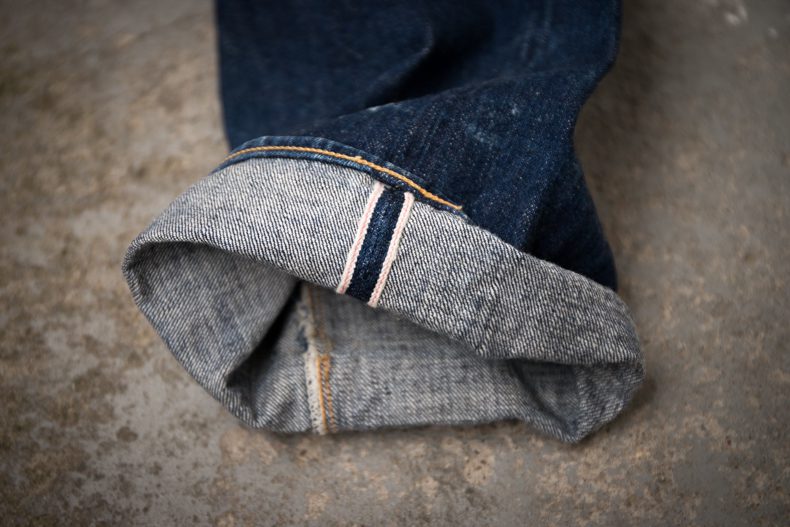Cuffing your raw denim seems simple, right. Wrong! There are a few things to remember before you make that first roll and Rope Dye’s here to help!
So, you have your new jeans. They fit you perfectly in the waist, through the thigh, down through the knee but they are about 5 inches too long in the leg! What to do?!?
Worry not, Rope Dye is here to help.
Why are the jeans so long?
The thing is, a lot of the higher-end raw denim jeans come in a standard inseam size. And this inseam is LONG! Chances are you will have to shorten the length somewhat. There are two ways you can go about this. The first is getting them hemmed. I will go into this in detail later down the line, but just a couple of words of warning quickly.
Use a pair of existing jeans or trousers to really nail the length you want. If they are unsanforized. Make SURE they are fully shrunk down before you have them hemmed. Even then you might want to leave an inch or so to take care of any shrinkage later on down the line.
Even if they are sanforized, you might also want to leave a little in the length. I have had sanforized jeans shrink a bit once or twice.
Your second option that many denimhead just love is cuffing.
Historically, jeans were only manufactured in one standard length. The reason for this was twofold (pun totally intended). Back in the days, all jeans were unsanforized and, therefore, shrink-to-fit. Making only one length was also practical from a manufacturing standpoint. It was simpler for the factory and better for the merchants.
Instead of having a wide range of varying sizes of waist and length combinations, only the waist dimensions changed. If there was no tailor to hand, or they could not afford it, the miners and the cowboys would roll up their jeans to the right length.
Cuffing remained a popular and viable way of altering the length of jeans for almost 100 years. Cuffs were iconized by Marlon Brando in The Wild One, wearing his Levi’s 501 jeans, and James Dean, most often seen in Lee’s.
And then along came the 60 and 70s and brought along weird fashion fits like flares, sanforization as standard and shitty quality denim. But this shitty sanforized denim was stable and people could buy their correct inseam and be sure it would remain the right length.
Around this time, the selvedge edge was on its way out. The narrower shuttle looms were replaced by more modern looms that didn’t self-lock the edge of the fabric. No longer could you flash your selvedge ID.
Then we went the denim dark ages. For a couple of decades, this cheap denim was all that was readily available. Thankfully those dark times are over. We can again find beautiful selvedge fabric and proudly fly the flag of quality denim by cuffing our jeans.
Keep a couple of things in mind!
Cuffing your jeans is simple, but there are a few things to keep in mind and a few ways to do it! The first thing you should do is find out if your jeans are made from sanforized or unsanforized denim. If it is sanforized then you can find the right length and cuff right away. Although at Rope Dye we DO wholeheartedly recommend an initial soak. Even sanforized denim can shrink a little and this will take care of that. If the denim is unsanforized then there’s no way around soaking the jeans in warm to hot water to shrink down the fabric.
You are probably wondering, why is getting the shrink out so important and you can just change the cuffs later down the line. Well, not really. First off, length is important for the overall fit and look of the jeans. When it comes to cuffing, getting the length wrong can lead to unnecessary damage and ill-fitting jeans.
Just think about it. You cuff your unsanforised jeans to the perfect length. You are super happy for 8 months until the first wash and the jeans are 3 inches shorter. Not cool!
Finding the Right Length
This is not as easy as it sounds and requires a little trial and error. Put the jeans on and adjust them to where you normally wear them on the waist. Fold the leg of the jean back on itself revealing the selvedge edge. Adjust it to the correct length for your inseam.
Now jump up and down on the spot for a while and see where the jeans sit. Adjust the length of the cuff as necessary.
A lot of guys will leave their jeans an inch or more too long. This may look acceptable initially, maybe even kind of cool. But when the jeans start to settle and mould to your body it will result in a very ill-fitting pair of jeans. The dreaded drooping knee bags being the most obvious sign of this.
Choose Your Length To Match Your Shoes
Getting really geeky about this (and let’s face it, we love to do that) your choice of footwear can also have an impact on the length to which you cuff your jeans. If Red Wings are your thing, a good rule of thumb is to have the length about an inch off the floor when you are standing up straight. If you are more the Converse/sneaker type, then a quarter inch of space between the floor and the hem will serve you well.
Setting Your Cuff
When you start wearing your cuffed jeans day in, day out the cuffs will set in and create a prominent ridge. This happens remarkably quickly. Once this happens you will not be able to go alter the cuff without having a telltale line showing you messed up. Now you can see why it is so essential to get it right first time!
What Cuff is Right For You
Ok, so you have your length dialled in. Cool. Now its time to decide on what kinda cuff you’ll be rocking for the foreseeable future. Now, here are our top five picks over here at Rope Dye.
The Straight Fold Back
The simplest and most pure form of the cuff loved from cowboys to miners to bikers. Simply double the leg of your jean back on itself. Easy!
The Multi Roll
The leg is rolled back in a thin cuff as many times as necessary to achieve the right length. Avoid using this solution if there is a great deal of length to be taken up. The cuff can end up looking more like a doughnut.
The Inner Roll
Some guys like this because of the clean look and over time it will lead to some totally unique fades. The only pain in the ass is that you’ll have to tuck it up and in every time you put your jeans on.
The Double Cuff With Exposed Chain Stitch
One problem with cuffing is that can it hide that beautiful chain stitched hem. This is the perfect way around this. Do a rather high straight fold back, then roll once more to just under the chain stitched hem. You get the best of both worlds.
The Pin Roll.
Now, this is one I borrowed from the sneakerheads and I have only just recently started to use it. But I LOVE IT. The Pin Roll seems to cover a variety of bases. Good for trainers. Good for shoes. Good for mid-length boots, Good for higher lace-ups. It has the added bonus of being not so widely used in the world of selvedge denim. I can’t wait to see the fades I get through all these cuffings.
Also, it has stopped the issue of the cuffs setting in. The denim is totally undamaged at the hem. Normally by this time, I would be seeing some fraying with the more traditional methods.
But ok, how do we do this. It seems tricky at first, but you just need to practise a couple of time and it gets easy. I always start with a single small cuff. Then bring narrow down the leg opening by folding the inseam back on itself. While holding this. roll the hem back on itself a couple of time. There you have it. It’s all locked in place.
The Pin Roll requires a little more effort because you have to do it each time to put the jeans on. But I find the versatility makes it well worth the extra effort.
Watch out! Denim Danger!
Finally, just to round this whole thing out. A word on the dangers of cuffing. Aside from the wear and tear the cuffed hemline goes through and the resulting damage. There are some physical consequences of cuffing your jeans which simply cannot be avoided.
It will damage the denim. The fold where the jeans are cuffed gets a lot of abuse. It will wear down quickly, fray and rip. This is inevitable I’m afraid. Personally, I find this a great part of the breaking in the process but I know many who hate it.
The cuff is essentially an open pocket right down on the floor. It will collect an incredible amount of dirt and grime. Over the years, I have found rocks, sticks, coins, cigarette butts and once a girls phone number. Clean them out regularly. It could lead to a beautiful love story.
The biggest danger of all is not to the jeans, but to the wearer. Cuffs can and do catch on things. This will be essential to take into account for bikers or people working around heavy machinery. If so, ask yourself if you wouldn’t be better served to hem your jeans. At least make sure your cuffs are tightly rolled. No 10-inch straight folds.


